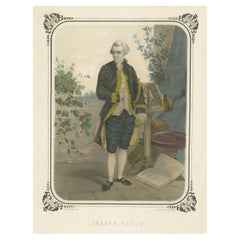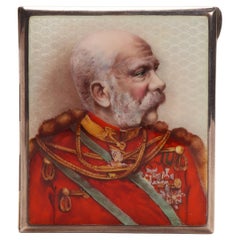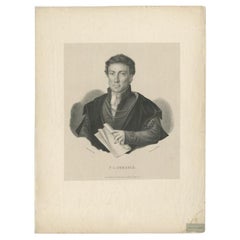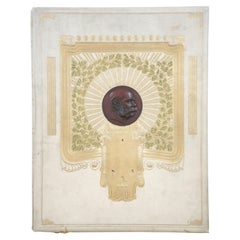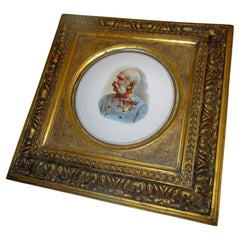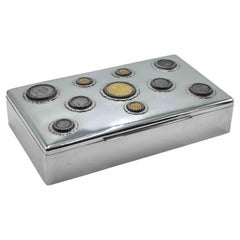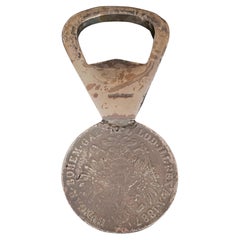Franz Joseph
to
32
169
92
285
13
12
12
7
5
4
2
1
1
1
1
1
19
183
83
46
26
4
19
6
3
4
2
12
3
1
2
143
98
98
71
24
236
172
18
18
11
283
283
283
9
8
4
3
3
Sort By
Antique Portrait of Franz Joseph Haydn
Located in Langweer, NL
Antique print titled 'Joseph Haydn'. Old portrait of Franz Joseph Haydn. The portrait showcases a
Category
Antique Late 19th Century Prints
Materials
Paper
Kaiser Franz Joseph 1 Eduard Mahner, Antik, Zinn, Jubiläum, Kaiser, Becher Um 18
Located in Vienna, AT
Emperor Franz Joseph 1 Eduard Mahner, antique, pewter, jubilee, emperor, mug around 1848, antique
Category
Antique 1890s Glass
Materials
Pewter
$585
H 3.94 in W 2.96 in D 2.96 in
Enameled silver cigarette case with a portrait of Franz Joseph, Italy 1900.
Located in Milan, IT
guilloché prepared bed. The miniature depicts Emperor Franz Joseph of Austria (1830 - 1916), in Hungarian
Category
Early 20th Century Italian Tobacco Accessories
Materials
Silver, Enamel
$2,986
H 9 in W 8 in D 1.5 in
Antique Portrait of Ludwig Franz Joseph Dumbeck by Lemonnier, 1827
Located in Langweer, NL
Antique portrait titled 'F.I. Dumbeck'. Portrait of Ludwig Franz Joseph Dumbeck. This print
Category
Antique 19th Century Prints
Materials
Paper
$420 Sale Price
20% Off
H 22.45 in W 16.74 in D 0 in
Antique Viribus Unitis Kniha o Cisari Book of the Emperor Franz Joseph I 18"
Located in Dayton, OH
50th Anniversary of the cornoation of Emperor Franz Joseph I of Austria. Includes stunning art nouveau
Category
Antique 19th Century Books
Materials
Paper
$1,000 Sale Price
20% Off
H 18.25 in W 14 in D 2.5 in
Original Vintage Travel Poster Kaiser Franz Joseph Haus Hotel Austria Lechner
Located in London, GB
Kaiser-Franz-Josef-Haus Grossglockner Hochalpenstrasse 2418m Osterreich Austria. Great artwork by Hubert
Category
Vintage 1920s Austrian Posters
Materials
Paper
$2,377
H 33.08 in W 22.45 in D 0.04 in
KPM Porcelain Painting of Franz Josef of Austria in Ornate Giltwood Frame
By KPM Porcelain
Located in Savannah, GA
This detailed KPM porcelain plaque features a painting of Franz Joseph and is beautifully
Category
Antique Early 1900s German Baroque Revival Historical Memorabilia
Materials
Porcelain, Giltwood
$972 Sale Price
34% Off
H 14.5 in W 14.5 in D 2 in
Vintage Silver Box, Austria, 19th Century
Located in Roma, IT
.
Starting from the first row in order:
- Medallion 1 : A silver portrait of the Emperor Franz Joseph I of
Category
Antique 19th Century Hungarian Decorative Boxes
Materials
Silver, Gold
Silver Plated Brass Coin Bottle Opener by Carl Aubock, circa 1950
By Werkstätte Carl Auböck
Located in Vienna, AT
.
The front shows a Facsimile coin, dated 1881, with a portrait of Franz Joseph I facing right.
With an
Category
Mid-20th Century Austrian Mid-Century Modern Barware
Materials
Brass
Antique Map of Southern Zeeland by Von Reilly, 1790
Located in Langweer, NL
' (Wien: Reilly, 1791-1806), a world atlas in 830 maps by Franz Joseph Johann von Reilly. Artists and
Category
Antique 18th Century Maps
Materials
Paper
$189 Sale Price
20% Off
H 16.86 in W 18.19 in D 0 in
Painting oil on canvas with wild stags. By Johann Frankenberger, Germany 1840.
Located in Milan, IT
of intense portraits (including the official one of Emperor Franz Joseph) and landscapes. Austria
Category
Antique Mid-19th Century Austrian Paintings
Materials
Canvas, Fruitwood
$5,734
H 30.25 in W 36 in D 2.25 in
Antique Map of Overijssel and Drenthe by Von Reilly, c.1795
Located in Langweer, NL
atlas in 830 maps by Franz Joseph Johann von Reilly. Artists and Engravers: Franz Joseph Johann von
Category
Antique 18th Century Maps
Materials
Paper
$148 Sale Price
20% Off
H 12.6 in W 14.97 in D 0 in
Joseph Franz Pallenberg, Bear, German Art Deco Bronze Sculpture, ca. 1920s
By Joseph Franz Pallenberg
Located in New York, NY
German Art Deco
Joseph Franz Pallenberg
Bear
Patinated Bronze
ca. 1920’s
Signed “Jos. Pallenberg
Category
Vintage 1920s German Art Deco Animal Sculptures
Materials
Bronze
$3,900
H 8 in W 8.5 in D 7.5 in
Antique Map of Overijssel and Drenthe by Von Reilly, c.1795
Located in Langweer, NL
by Franz Joseph Johann von Reilly. Artists and Engravers: Franz Joseph Johann von Reilly (1766-1820
Category
Antique 18th Century Maps
Materials
Paper
$143 Sale Price
20% Off
H 11.03 in W 14.06 in D 0 in
Antique Map of Part of Overijssel by Von Reilly, 1792
Located in Langweer, NL
Engravers: Franz Joseph Johann von Reilly (1766-1820) was a Vienna based art dealer. He is also known as the
Category
Antique 18th Century Maps
Materials
Paper
$119 Sale Price
20% Off
H 11.42 in W 14.18 in D 0 in
Antique Map of Part of Groningen by Von Reilly, 1792
Located in Langweer, NL
and Engravers: Franz Joseph Johann von Reilly (1766-1820) was a Vienna based art dealer. He is also
Category
Antique 18th Century Maps
Materials
Paper
$100 Sale Price
20% Off
H 11.42 in W 14.18 in D 0 in
Vintage Austro-Hungarian Tankard, 19th Century
Located in Roma, IT
decorations depicting the portrait or the coat of arms of the Emperor Franz Joseph I of Austria (1848-1916) on
Category
Antique 19th Century Hungarian Vases
Materials
Silver, Gold
Antique Map of Oostergo by Von Reilly, 1791
Located in Langweer, NL
orginates from 'Schauplatz der fünf Theile der Welt'. Artists and Engravers: Franz Joseph Johann von Reilly
Category
Antique 18th Century Maps
Materials
Paper
Antique Map of Oostergo by Von Reilly, 1791
Located in Langweer, NL
Engravers: Franz Joseph Johann von Reilly (1766-1820) was a Vienna based art dealer. He is also known as the
Category
Antique 18th Century Maps
Materials
Paper
Fine Collection of Custom Framed Vintage Cigar Labels
Located in Bridgeport, CT
- Franz Joseph I, and other rulers. Along with a serrated round label with a bust in profile at the top
Category
20th Century Hollywood Regency Tobacco Accessories
Materials
Linen, Glass, Wood, Paper
Bronze Portrait Bust of a Black Man 'Marbruk' by Arthur Kaan
Located in Amsterdam, NL
children and of memorial statues for Emperor Franz Joseph, the Mayor of Vienna Porzer, the composer A.M
Category
Antique Late 19th Century Austrian Busts
Materials
Marble, Bronze
Antique Map of Friesland by Von Reilly, 1791
Located in Langweer, NL
orginates from 'Schauplatz der fünf Theile der Welt'. Artists and Engravers: Franz Joseph Johann von Reilly
Category
Antique 18th Century Maps
Materials
Paper
Moser Pink Glass Pillow Vase
By Moser Glassworks
Located in New Orleans, LA
"The Glass of Kings," Moser served as the Court Purveyor to Kaiser Franz Joseph I, King Edward VII, and
Category
Early 20th Century Austrian Bohemian Vases
Materials
Glass, Art Glass
A fine 19th c Palatial painting entitled " Venetian Festival" by August Wolf
Located in Dallas, TX
holds that this monumental work was commissioned directly by Emperor Franz Joseph 1 of Austria, who
Category
Antique Late 19th Century Italian Renaissance Revival Paintings
Materials
Canvas
$28,500
H 84 in W 122 in D 3 in
"Sailing Ship and Dolphins, " Important Mid-Century Bowl with Vivid Enamels
By Karl Drerup
Located in Philadelphia, PA
ceramics with Franz Joseph Von Tury, but later he focused on enamel painting, prompted in part by a
Category
Vintage 1950s American Mid-Century Modern Decorative Bowls
Materials
Enamel
$3,120 Sale Price
20% Off
H 2 in Dm 10 in
"Cones and Olives, " Superb Footed Enamel Dish Depicting Sea Shells
By Karl Drerup
Located in Philadelphia, PA
worked in ceramics with Franz Joseph von Tury, but later he focused on enamel painting, prompted in part
Category
Vintage 1950s American Mid-Century Modern Decorative Bowls
Materials
Enamel
Two Green Moser Crystal Pillow Vases w/ Applied Raised Enamel Falcons and Acorns
By Moser Glassworks
Located in New York, NY
served as the Court Purveyor to Kaiser Franz Joseph I, King Edward VII, and the Shah of Persia. These
Category
Antique 1890s Czech Bohemian Glass
Materials
Crystal
$12,800 / set
H 8 in W 7 in D 4.25 in
"Spouting Whale, " Mid-Century Masterpiece of Enamel Painting by Drerup
By Karl Drerup
Located in Philadelphia, PA
Germany. In his early years in America, he worked in ceramics with Franz Joseph Von Tury, but later he
Category
Vintage 1950s American Mid-Century Modern Decorative Bowls
Materials
Enamel
$3,360 Sale Price
20% Off
H 2 in Dm 10 in
"Circus Scene, " Masterpiece Enamel Bowl w/ Trapeze Artists in Deep Red and Green
By Karl Drerup
Located in Philadelphia, PA
Franz Joseph Von Tury, but later he focused on enamel painting, prompted in part by a conversation with
Category
Vintage 1950s American Mid-Century Modern Decorative Bowls
Materials
Enamel
$3,200
H 2.25 in Dm 10 in
"Nativity", Brilliant Enamel Panel in Blue, Purple and Orange by Karl Drerup
By Karl Drerup
Located in Philadelphia, PA
his early years in America, he worked in ceramics with Franz Joseph von Tury, but later he focused on
Category
Vintage 1950s American Mid-Century Modern More Furniture and Collectibles
Materials
Enamel
$2,080 Sale Price
20% Off
H 7.75 in W 10.75 in D 2 in
"Fishermen in the Mediterranean, " Important Mid-Century Enamel by Drerup
By Karl Drerup
Located in Philadelphia, PA
them to leave Germany. In his early years in America, he worked in ceramics with Franz Joseph Von Tury
Category
Vintage 1950s American Mid-Century Modern Decorative Bowls
Materials
Enamel
19th C. Diminutive Plaster Phrenology Head, Atribb. A.L. Vago London, C.1870
By Vago
Located in West Palm Beach, FL
the brain.
Phrenology, a now-discredited theory pioneered by Franz Joseph Gall, aimed to map mental
Category
Antique 19th Century English High Victorian Scientific Instruments
Materials
Plaster
$920 Sale Price
20% Off
H 6 in W 3 in D 3 in
"Noah's Ark" Enamel Bowl, Masterpiece of Mid Century Artistry by Drerup
By Karl Drerup
Located in Philadelphia, PA
heritage forcing them to leave Germany. In his early years in America, he worked in ceramics with Franz
Category
Vintage 1950s American Mid-Century Modern Decorative Bowls
Materials
Enamel
'Grand Nu Aux Feuillages', a Fine Patinated Bronzed Figural Group, circa 1900
By Alois Mayer
Located in Brighton, West Sussex
Franz Joseph and Regina Mayer, little is known of Alois‘s early life. He studied at the Munich Academy
Category
Antique Late 19th Century German Figurative Sculptures
Materials
Bronze, Iron
$22,379
H 58.27 in W 19.69 in D 15.75 in
Contina AG Mauren Curta I Mechanical Calculator
Located in Mexico City, MX
Austria, where he met Prince Franz Joseph of Liechtenstein, who showed interest on the production of the
Category
Vintage 1960s Liechtenstein Mid-Century Modern Scientific Instruments
Materials
Metal
Early 19th c. Porcelain Phrenology Stamp/Pipe Stamper c.1820
Located in San Francisco, CA
idiosyncratic Viennese physician Franz Joseph Gall (1758-1828).
CREATOR L.N. Fowler, London, UK.
DATE
Category
Antique Early 19th Century Paperweights
Materials
Gold, Brass
$1,095 Sale Price
57% Off
H 3.25 in W 1.25 in D 1.25 in
Herend Apponyi Pink Porcelain Vase from the 1950s
By Herend
Located in Milano, MI
, receiving royal patronage from Queen Victoria and Emperor Franz Joseph of Austria.
Herend porcelain is
Category
Vintage 1950s Hungarian Arts and Crafts Vases
Materials
Porcelain
Large art deco vitrine by Lingel
By Lingel Workshop
Located in Banská Štiavnica, SK
accessories for St. Matthias Church for the coronation of Franz Joseph I. It also participated in the
Category
Vintage 1920s Hungarian Art Deco Vitrines
Materials
Wood
Art deco showcase by Lingel
By Lingel Workshop
Located in Banská Štiavnica, SK
accessories for St. Matthias Church for the coronation of Franz Joseph I. It also participated in the
Category
Vintage 1930s Hungarian Art Deco Vitrines
Materials
Glass, Walnut
Large showcase by Lingel
By Lingel Workshop
Located in Banská Štiavnica, SK
it produced the coronation accessories for St. Matthias Church for the coronation of Franz Joseph I
Category
Vintage 1930s Hungarian Art Deco Vitrines
Materials
Glass, Wood
Antique Map of the Wadden Islands, 1792
Located in Langweer, NL
and Engravers: Franz Joseph Johann von Reilly (1766-1820) was a Vienna based art dealer. He is also
Category
Antique 18th Century Maps
Materials
Paper
A Rare Austrian Art Nouveau Silver and Enamel Owl Seal by Georg Adam Scheid
Located in Queens, NY
of Franz Joseph, Scheid exhibited at prestigious venues such as the 1889 Jubilee Exhibition and the
Category
Early 20th Century Austrian Art Nouveau Desk Sets
Materials
Silver, Enamel
Cuenco de bronce Gustav Gurschner
By Gustave Gurschner
Located in Buenos Aires, Argentina
day, artists stood next to their works while Kaiser Franz Joseph passed in review. Amid the other
Category
Vintage 1910s Austrian Art Deco Decorative Bowls
Materials
Bronze
Art Deco Chest of Drawer or Commode Signed Lingel 1930'
Located in Rome, IT
Franz Joseph I. It also participated in the decoration of the Buda Castle Palace, the People's Theatre
Category
Vintage 1930s Hungarian Art Deco Commodes and Chests of Drawers
Materials
Walnut
$5,360 Sale Price
20% Off
H 33.47 in W 39.38 in D 23.63 in
Antique Map of the Westerkwartier Region, a Region in Groningen, 1791
Located in Langweer, NL
'.
Artists and Engravers: Franz Joseph Johann von Reilly (1766-1820) was a Vienna based art dealer. He is
Category
Antique 18th Century Maps
Materials
Paper
$406
H 11.62 in W 13.78 in D 0 in
Antique Map of Westergo in Friesland, 1791
Located in Langweer, NL
orginates from 'Schauplatz der fünf Theile der Welt'.
Artists and Engravers: Franz Joseph Johann von
Category
Antique 18th Century Maps
Materials
Paper
J. Brunner 1869 Oil on Canvas Austrian Landscape with Lake and Mountain Painting
By Joseph Brunner
Located in Firenze, IT
. Bild einer Epoche. Die Erweiterung der Inneren Stadt Wien unter Kaiser Franz Joseph. Band 10. Wiesbaden
Category
Antique 19th Century Austrian Barbizon School Paintings
Materials
Canvas, Wood, Paint
$8,840
H 30.32 in W 43.31 in D 1.97 in
Antique Map of the Region of Bolsward and Sneek by Von Reilly, 1791
Located in Langweer, NL
'Schauplatz der fünf Theile der Welt'.
Artists and Engravers: Franz Joseph Johann von Reilly (1766-1820) was
Category
Antique 18th Century Maps
Materials
Paper
$151 Sale Price
20% Off
H 11.42 in W 15.56 in D 0 in
Antique Map of the Region of Leeuwarden and Dokkum in The Netherlands, 1791
Located in Langweer, NL
'Schauplatz der fünf Theile der Welt'.
Artists and Engravers: Franz Joseph Johann von Reilly (1766-1820) was
Category
Antique 18th Century Maps
Materials
Paper
$150 Sale Price
20% Off
H 11.42 in W 15.56 in D 0 in
Antique Map of the Region of Gaasterland, Friesland, The Netherlands, 1791
Located in Langweer, NL
Netherlands. This map orginates from 'Schauplatz der fünf Theile der Welt'.
Artists and Engravers: Franz
Category
Antique 18th Century Maps
Materials
Paper
$286
H 11.42 in W 12.41 in D 0 in
Antique Map of the Region of Franeker and Harlingen by Von Reilly, 1791
Located in Langweer, NL
'Schauplatz der fünf Theile der Welt'.
Artists and Engravers: Franz Joseph Johann von Reilly (1766-1820
Category
Antique 18th Century Maps
Materials
Paper
$151 Sale Price
20% Off
H 11.42 in W 15.56 in D 0 in
Antique Map of the Region of Bolsward and Sneek by Von Reilly, 1791
Located in Langweer, NL
'Schauplatz der fünf Theile der Welt'.
Artists and Engravers: Franz Joseph Johann von Reilly (1766-1820
Category
Antique 18th Century Maps
Materials
Paper
$146 Sale Price
20% Off
H 11.82 in W 15.16 in D 0 in
Large Signed Oval Marble Ashtray or Centerpiece With Two-Bronze Eagles
By Joseph Franz Pallenberg
Located in Haddonfield, NJ
" on the base of the eagle, Joseph Franz Pallenberg (Germany 1882-1946).
Category
Antique Early 19th Century German Art Deco Ashtrays
Materials
Marble, Bronze
$500
H 5.25 in W 12.25 in D 9.4 in
Mandolin Singing Bird Automaton Music Box
Located in New Orleans, LA
displayed inside the lid, along with a second seal: “Wellausstellung 1875 Wien Franz. Joseph I. Kaiser
Category
Antique 19th Century Austrian Other Musical Instruments
Materials
Satinwood
Beautiful Late 19th Century Berlin K.P.M.–Vienna Style Porcelain Plaque 5 Senses
By Königliche Porzellan-Manufaktur (KPM)
Located in Long Island City, NY
anniversary of Franz Joseph and Empress Elizabeth in 1879. The present work is painted after his five
Category
Antique Late 19th Century German Belle Époque Porcelain
Materials
Porcelain, Wood
$75,000
H 12 in W 16 in D 2 in
Large secession dining table by Karoly Lingel Budapest
By Lingel Workshop
Located in Banská Štiavnica, SK
it produced the coronation accessories for St. Matthias Church for the coronation of Franz Joseph I
Category
Vintage 1910s Hungarian Vienna Secession Dining Room Tables
Materials
Copper
1792 German Heraldic Gouache, Ink and Watercolor with Imperial Inscription
Located in Morristown, NJ
crowned crests, and elaborate mantling, is reminiscent of artists such as Franz Joseph Lederer and
Category
Antique 1790s German Neoclassical Paintings
Materials
Wood, Paint, Paper
$1,375
H 11 in W 9.25 in D 1.5 in
Antique Silver Toilet Set for the Duke of Parma by Josef Carl Klinkosch
By Josef Carl Klinkosch
Located in London, GB
Franz Joseph (1830-1916) and Empress Sisi (1837-1898), this toilet set consists of 22 silver and
Category
Antique Late 19th Century Austrian Rococo Sterling Silver
Materials
Silver
$132,876 / set
H 22.45 in W 20.87 in D 1.58 in
- 1
Get Updated with New Arrivals
Save "Franz Joseph", and we’ll notify you when there are new listings in this category.
Franz Joseph For Sale on 1stDibs
Choose from an assortment of styles, material and more with respect to the franz joseph you’re looking for at 1stDibs. Each franz joseph for sale was constructed with extraordinary care, often using wood, bone and antler. You’ve searched high and low for the perfect franz joseph — we have versions that date back to the 19th Century alongside those produced as recently as the 20th Century are available. Each franz joseph bearing Art Deco hallmarks is very popular. Many designers have produced at least one well-made franz joseph over the years, but those crafted by Bernhard Bloch and Joseph Franz Pallenberg are often thought to be among the most beautiful.
How Much is a Franz Joseph?
The average selling price for a franz joseph at 1stDibs is $365, while they’re typically $349 on the low end and $14,950 for the highest priced.
